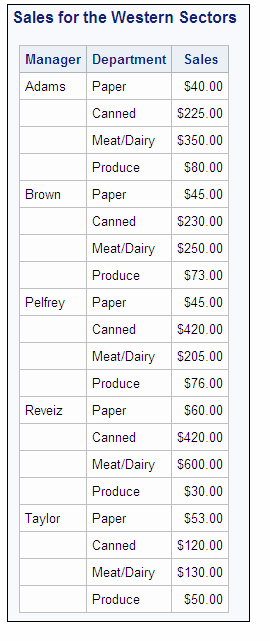REPORT Procedure
- Syntax

- Overview
- Concepts
- Using
- Results
- Examples
 Selecting Variables for a ReportOrdering the Rows in a ReportUsing Aliases to Obtain Multiple Statistics for the Same VariableConsolidating Multiple Observations into One Row of a ReportCreating a Column for Each Value of a VariableDisplaying Multiple Statistics for One VariableStoring and Reusing a Report DefinitionCondensing a Report into Multiple PanelsWriting a Customized Summary on Each PageCalculating PercentagesHow PROC REPORT Handles Missing ValuesCreating and Processing an Output Data SetStoring Computed Variables as Part of a Data SetUsing a Format to Create GroupsSpecifying Style Elements for ODS Output in the PROC REPORT StatementSpecifying Style Elements for ODS Output in Multiple StatementsUsing Multilabel FormatsUsing the WIDTH= and CELLWIDTH= Style Attributes with PROC REPORT
Selecting Variables for a ReportOrdering the Rows in a ReportUsing Aliases to Obtain Multiple Statistics for the Same VariableConsolidating Multiple Observations into One Row of a ReportCreating a Column for Each Value of a VariableDisplaying Multiple Statistics for One VariableStoring and Reusing a Report DefinitionCondensing a Report into Multiple PanelsWriting a Customized Summary on Each PageCalculating PercentagesHow PROC REPORT Handles Missing ValuesCreating and Processing an Output Data SetStoring Computed Variables as Part of a Data SetUsing a Format to Create GroupsSpecifying Style Elements for ODS Output in the PROC REPORT StatementSpecifying Style Elements for ODS Output in Multiple StatementsUsing Multilabel FormatsUsing the WIDTH= and CELLWIDTH= Style Attributes with PROC REPORT
Example 8: Condensing a Report into Multiple Panels
| Features: |
BREAK statement options: SKIP |
| Other features: |
SAS system option FORMCHAR= |
| Data set: | GROCERY |
| Formats: | $MGRFMT |
Program
libname proclib
'SAS-library';
options fmtsearch=(proclib);
proc report data=grocery nowd headline
formchar(2)='~'
panels=99 pspace=6
ls=64 ps=18;
column manager department sales;
define manager / order
order=formatted
format=$mgrfmt.;
define department / order
order=internal
format=$deptfmt.;
define sales / format=dollar7.2;
break after manager / skip;
where sector='nw' or sector='sw';
title 'Sales for the Western Sectors'; run;
Program Description
Specify the format search library.The SAS system option FMTSEARCH= adds the SAS library
PROCLIB to the search path that is used to locate formats.
Specify the report options. The
NOWD option runs PROC REPORT without the REPORT window and sends its
output to the open output destinations. HEADLINE underlines all column
headings and the spaces between them at the top of each panel of the
report. FORMCHAR= sets the value of the second formatting character
(the one that HEADLINE uses) to the tilde (~). Therefore, the tilde
underlines the column headings in the output.
HEADSKIP writes a blank line beneath the underlining
that HEADLINE writes. LS= sets the line size for the report to 64,
and PS= sets the page size to 18. PANELS= creates a multipanel report. Specifying PANELS=99
ensures that PROC REPORT fits as many panels as possible on one page.
PSPACE=6 places six spaces between panels.
Define the sort order and analysis columns. The values of all variables with the ORDER option
in the DEFINE statement determine the order of the rows in the report.
In this report, PROC REPORT arranges the rows first by the value of
Manager (because it is the first variable in the COLUMN statement)
and then, within each value of Manager, by the values of Department.
The ORDER= option specifies the sort order for a variable. This report
arranges the values of Manager by their formatted values and arranges
the values of Department by their internal values (np1, np2, p1, and
p2). FORMAT= specifies the formats to use in the report.
define manager / order
order=formatted
format=$mgrfmt.;
define department / order
order=internal
format=$deptfmt.;
define sales / format=dollar7.2;
Produce a report summary. This
BREAK statement produces a default summary after the last row for
each manager. Because SKIP is the only option in the BREAK statement,
each break consists of only a blank line.
